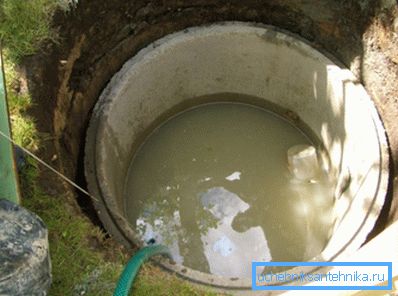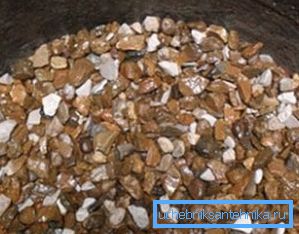Muddy water in the well - what to do
The price of the drilling of some of the owners is quite hard to beat. Probably, in part, that is why they are piously convinced that “having paid off” in this way, their family will be provided with clean and clear water for life. However, quite often a surprise awaits them: muddy water in a well is one of the most common troubles.
We will try to talk about the reasons why the water from the well grows cloudy and how to solve this problem.

Causes of cloudy water
Finding mud with muddy impurities that flow from a tap with hitherto crystal clear water, it is necessary to contact specialists as soon as possible to find out the cause of this phenomenon.. Troubleshooting methods and repair costs will depend on this.
Biological causes
We are surrounded by billions of invisible microorganisms, they multiply, die, throw waste products into the environment. Naturally, they live not only on the surface of the earth and in the air, in the water, including in the well, they also abound.
Water from the well becomes cloudy due to:
- Flowering or silting - this happens if microscopic algae get into the water;
- Infection with bacteria - such water will at least provide you with an upset stomach.
Decision:
The main means of maintaining the purity of water - prevention, timely sanitation. It may be necessary to install or replace old disinfecting filters, or to clean the column using a chopper.

Chemical causes
One of the reasons why muddy water goes from the well may be chemical reactions.
- Chemical contamination of groundwater - occurs as a result of man-made disasters: emissions of chemical plants, oil spills, etc.
Solution: water from wells located in areas of chemical deprivation cannot be used. It will take a long time before the aquifers fill up with a clean, drinkable liquid.
- Iron oxidation reaction. As mentioned above, a lot of microorganisms live around us, including in the water. Iron is the product of the vital activity of one of the species of living beings who prefer the coolness of an artesian well.
However, a chemical oxidation reaction is possible only if two conditions coincide - the presence of iron and oxygen. The latter enters the water if there is a depressurization of the trunk.
Solution: a fully sealed barrel and filter will help you see the water in the well again.

Mechanical causes
We include all the problems caused by mistakes in the course of drilling a well and improper operation of the equipment:
- Dusting - occurs as a result of violation of the installation technology of well columns. The gravel pad, falling asleep in the bottom (bottom) and preventing the ingress of limestone and sand into the water, is washed away, and the bottom filter is no longer able to cope with the purification of water.
Solution: cleaning the wellbore by punching (forcing) and filling the gravel bed.
- Breakage or deterioration of the bottom filter - like all the equipment, the filter is designed for a certain period of operation. Over time, it can become clogged or just fail.
Solution: equipment replacement.
- Casing rupture (depressurization) - this trouble can occur due to the displacement of moving rock layers, and also as a result of improper installation of pipes and their reinforcement devices. And although the presence of a good filter allows you to use water for domestic needs, restoring the integrity of the column is paramount.
Solution: flushing the well and eliminating cracks in the pipe or drilling a new source.
- Blockage of the intake part due to casing failure - the well operating instruction strictly prohibits the use of vibratory pumps.
Solution: equipment replacement and well cleaning.

Where does clay come from in water
It is especially unpleasant and costly if muddy water and clay comes from the well. This type of pollution must be taken especially carefully, it is fraught with "loss" of the source of drinking water.
Methods of fighting for clean water vary depending on the "age" of the well.
Water mixed with clay, coming from an old, time-tested source, can be such for the following reasons:
- Depressurization of the casing, in this case, the clay from the impermeable layer begins to flow freely into the well;
- The banal breakdown of the downhole filter - all the suspension and dregs that it held up, turns out to be in clean water.
And in fact, and in another case, a well overhaul is necessary.
Tip! It is possible to do a complete overhaul with your own hands, but it is better not to skimp and invite experts: pull out the drill string and eliminate tightness is not possible for any inexperienced driller. In some cases, the decision on the appropriateness of such repairs should be made by a professional - sometimes it is cheaper and more practical to drill a new source.

There are three main reasons why a new source “pleases” owners of muddy, clayey waters, and all of them are somehow connected with the violation of drilling technology:
- Poorly cased pipes that do not isolate water from the surface (upper lines) from the water layer. Thus, sand and clay particles easily fall into the aquifer and end up in your glass.
It is quite simple to solve the problem - it is enough to seal the annulus with cement mortar;
- Improper well location - you can not drill near the reservoir, especially with the one in which the clay bottom. The way out in this case is a new well;
- Source clay is a professional mistake of drillers who didn’t consider it necessary to replace the washing mud with technical water before opening the aquifer.
Because of this misstep, the clay particles literally scattered across the aquifer. Can I remove them? Can! To do this, you need to pump, pump, and once again pump water from a well. There are no other options.
Summary
As you can see, muddy water from the well is capable of delivering a lot of trouble, worries and introducing additional costs to the owners. We have tried to more fully illuminate the reasons why muddy water is in the well, and how to eliminate them. The video in this article will show you the most common methods of fighting for transparent and safe water from your own source.